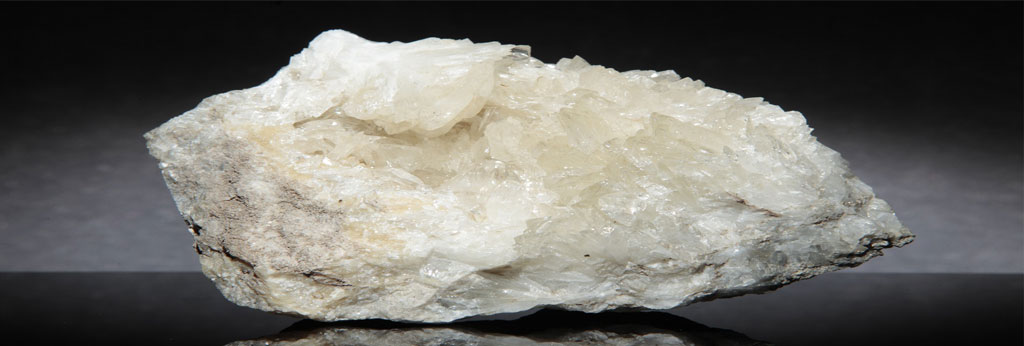The name of Colemanite is taken from the name of William T. Coleman, the founder of the borax factory in San Francisco. Colemanite with the chemical formula Ca2B6O11.5H2O is a hydrated calcium borate that contains 30-40% of B2O3. Colemanite is a group of minerals and exhibits strong luminescence intense green-black or black fluorescence. It dissolves in HCl under flame. Colemanite is classified as borate and has no magnetic properties, and its origin is sedimentary.
What is Colemanite?
Colemanite was discovered for the first time in Turkey and its characteristics include:
• Crystal shape: prismatic – same shape and size
• Color: white-gray
• Transparency: transparent and semi-opaque
• Fracture: half shell – irregular
• Crystallization system: monoclinic
• Pyramids at both ends
• Granular texture to mass components
Colemanite is white or colorless, but its color may be seen as pink or red due to the presence of impurities. This ore is distinguished from other minerals of the group by its hardness of 4.4-5 and specific gravity of 2.26-2.48, which is harder and heavier. Figure (1) shows the structure of Colemanite.

Colemanite compounds are:
• B2O3
• CaO
• H2O
• MgO
Colemanite is insoluble in water but dissolves in acids and it makes a sound when losing water due to heat. Iron and arsenic compounds in Colemanite mineral are considered as harmful substances.
This mineral grows in the form of bright white, prismatic crystals, pyramids at both ends and granular texture to mass components and is white or colorless, insoluble in water but soluble in acids and often used in the production of boric acid.

The origin of the Colemanite
The investigation of the origin of Colemanite is complicated and it is often found as a secondary mineral, and its formation is in springs rich in calcium, which causes the sodium calcium minerals to change to calcium borate.
It occurs in marine sediments along with gypsum and other boron minerals. Colemanite crystallizes in the monoclinic system as prisms and granular masses and has a bright luster.
The Colemanite’s places of origin
Most of the Colemanite with borax is found in the following places:
• Lakes of the playas of California (Death Valley)
• Turkey
• Chile
• Mexico
• China
• India
• Kazakhstan
• Argentina
Colemanite in Iran
Since the country of Iran is located on the Alpine-Himalaya mountain belt in terms of geological conditions like Turkey, with a similar northwest-southeast trend, it can be said that Iran, like Turkey, can have a high potential of borax reserves.
Although known reserves like Turkey have not been proven in Iran, but due to the many similarities in terms of suitable basins and the necessary conditions for the formation of economic deposits of this mineral in Iran with economic boron deposits in other parts of the world, including Turkey, it can be hoped that there are valuable reserves of this mineral in many parts of the country.
Boron mineralization in northwestern Iran in Zanjan and East Azerbaijan provinces was reported more than 30 years ago, and in the last 20 years, a small amount of mixed borate minerals containing calcium and magnesium, Ca/Mg, has been produced. All boron extraction in Zanjan province has been carried out by open pit mining, mainly from the Qaragol boron mine and a very small amount from the inactive mines of Inche (near Qaragol).
In Iran, boron has been extracted mainly from deposits with a grade of 30-40% B2O3. Geologically, these deposits were formed around 12-18 million years ago at the end of the third geological period (Miocene).
Market Analysis and Insights
The global Colemanite market is anticipated to rise at a considerable rate during the forecast period, 2021 to 2027. In 2021, the market is growing at a steady rate and with the rising adoption of strategies by key players, the market is expected to rise over the projected horizon.
This report examines the competitive landscape of the Colemanite industry based on company profiles and efforts in value creation and product production. The report will help the Colemanite manufacturers, new entrants, and industry chain-related companies in this market with information on the revenues, sales volume, and average price for the overall market and the sub-segments across the different segments, by company, product type, application, and regions.
Colemanite Market Report
List of Top Key Players in Colemanite Market Report Are:
• Eti Maden
• U.S. Borax
• Rio Tinto
• Active Minerals International
• Borax Argentina S.A
• Quiborax
Application of Colemanite
• Steel Industry
• Plastics Industry
• Glass Fiber
• Other
Benefits of boron in glass industry: Durability, strength, unmatched clarity Borates are well-known for imparting these benefits:
• Enhanced durability
• Increased thermal, chemical, and impact resistance
• Electrical neutrality
• Better optical properties
• Infrared absorption
• Aqueous durability
Boric oxide: Essential to efficient glass manufacturing
Adding the right concentration of boric oxide or other borates to your batch gives you greater process control.
Borates play a central role, acting as both a flux and network former during production.
They improve energy efficiency by significantly lowering melting temperatures and inhibiting crystallization of glass. Lowering viscosity, resisting thermal shock, and curbing devitrification are also important borate characteristics enabling your products to withstand harmful conditions.

